The Greatest Suburban Electrification Scheme in the World
RAILWAYS OF BRITAIN - 5
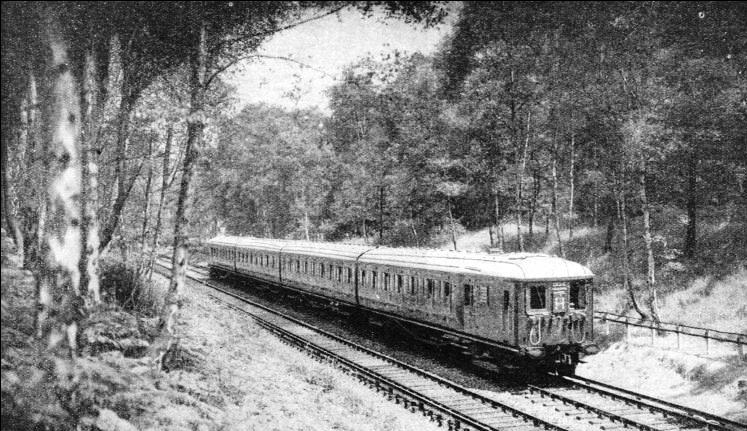
IN A SYLVAN SETTING. A Southern Railway electric train on the London to Reigate line.
MANY of the world’s most notable railway records are held by Great Britain. Among them is that of the largest single system of suburban railway electrification owned and worked by one railway company, to be found in or around any of the world's great cities. It is the Southern Railway Company that has earned, and richly deserves, this claim to fame. With commendable enterprise the directors of the company have electrified one section after another of their suburban lines, until the tentacles of this great electrified network now extend down to the South Coast. Already Brighton, Hove and Worthing are served by swift electric expresses from London; and further progress is always being made.
When the Southern Railway group was formed at the beginning of 1923, two of its three component parts, the London & South-Western, and London Brighton & South Coast Railways, had already electrified on an extensive scale; and the third - the South-Eastern & Chatham Railway - was on its way to the realization of another big scheme.
The old Brighton line was the first in the field. Spurred on to drastic measures by the competition of electric tramcars, the London, Brighton & South Coast Company first electrified its South London line, round from London Bridge to Victoria by way of Peckham Rye and Brixton, opening this route to electric traction in 1909, and followed with the lines from both these terminals to the Crystal Palace.
So successful were the results achieved that by 1913 a far bigger electrification scheme was prepared; but its carrying out was delayed by the War. It included the main line from London to Brighton. All this Brighton electrification was to have been carried out on the overhead system, with alternating current at 6,000 volts, 25 cycles; for it was thought that this would be the more economical method when it came to the long-distance electrifications to the coast.
It was in 1915 that the first electrified sections of the London & South-Western Railway were opened to traffic. In that year and in 1916, despite war difficulties, electrical operation came into use from Waterloo to Putney and Wimbledon, followed by the Kingston circular route, and the Shepperton, Hounslow, Surbiton, Hampton Court, and Claygate lines. The London & South-Western, however, standardized the third-rail for the purpose of conducting the current, and the use of direct current at 650 volts. When the Southern group was established, therefore, two large but entirely different systems of electrification, one overhead at 6,000 volts AC, and the other third-rail at 650 volts DC, were brought into association. A decision had to be reached as to which should survive; and it was the third-rail system that won. For the sake of uniformity, without which no through electric workings could be planned between the different parts of the London suburban area, it was decided to change over all the Brighton Railway’s overhead working to third-rail electrification, which in itself was a costly business. This work was completed in 1928 and 1929, and 650 volts DC is now standard for all the electrified Southern lines.
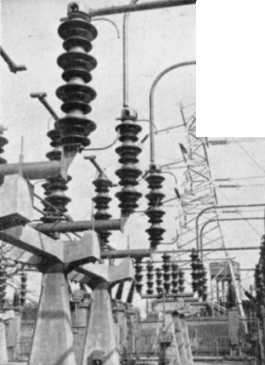
A MOTORMAN at the driving controls of an electric train. A clear view of the track ahead is provided by a large plate-glass window fitted with a wiper for use in wet or misty weather.
UNLIMITED POWER. High pressure alternating current is sent by means of overhead cables from the electric power-stations to sub-stations, such as that illustrated above. Here the current is transformed to a lower voltage for supply to the third rail of the track.
After the grouping of the railway companies electrification went on apace, and since then scarcely a single month has elapsed during which the Southern Railway has not had some sections at least of its lines in course of re-equipment. The Western Division (the late L&SWR) electrified lines have been extended to Guildford and Windsor; the Central division (the late LB&SCR) has carried its suburban electrification to Sutton, Dorking, and Reigate; and the Eastern Division (the late SE&CR), whose first electrified sections were brought into use in 1925 and 1926, has now extended them out as far as Gravesend and Sevenoaks. By 1930 a total of 307 miles of route, multiplying themselves out to 819 miles of single track, had been electrified by the Southern Railway on this uniform third-rail system, at 650 volts DC, employing 1,650 coaches, annually absorbing 326,000,000 kilowatt-hours of current in their movement, and - such has been the deserved success of this bold enterprise - carrying 218,000,000 passengers a year, and bringing in a gross revenue of £5,000,000.
The three original railways contributed between them no fewer than seven terminal stations in London to the possessions of the Southern Railway. The London & South Western owned only one of these - Waterloo - but it was a substantial contribution, with its 21 platforms. The London, Brighton & South Coast terminals comprised the Brighton sides at both London Bridge and Victoria, together offering 31 platforms. The South Eastern & Chatham was the richest in this respect, for it was itself an amalgamation of two previous lines - the South Eastern and London, Chatham & Dover - so having terminals at Cannon Street, Charing Cross, St. Paul’s, Holborn Viaduct, London Bridge, and Victoria, an addition of 39 to the number of platforms already given. This makes a total of 91 platforms at the London terminal stations of the Southern Railway, and so intensely busy is the suburban traffic that it is calculated that one electric Southern train is brought into London every fifteen seconds throughout the day.
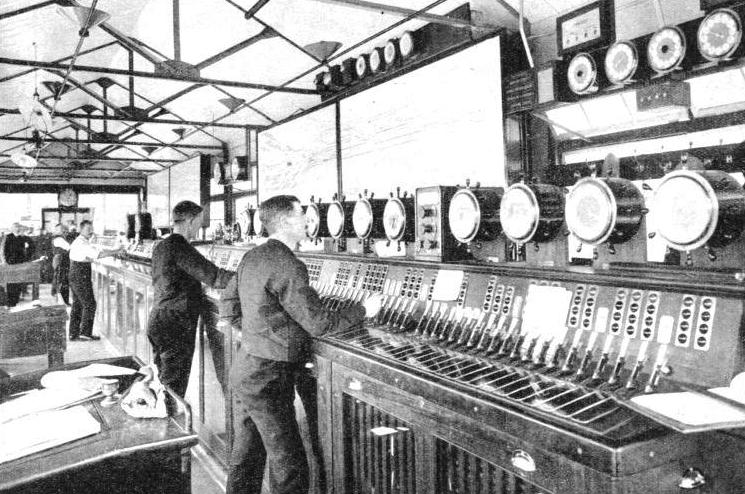
LONDON BRIDGE SIGNAL-BOX controls one of the most important railway stations in Great Britain. The electrically-operated cabin contains over three hundred levers, and all train movements in the vicinity are indicated by coloured lights on diagrams in front of the signalmen. A total of two thousand four hundred trains is handled every day at this station, which has six through tracks as well as fifteen terminal platforms.
Then, at last, twenty years after the plans had been first prepared, there came the realization of the long-cherished dream of express electric trains from London to Brighton. New Year’s Day, 1933, saw the inauguration of Britain’s first main line electrification scheme. The first stage, continuing the suburban electrification from Coulsdon to Three Bridges, had come into use in the summer of 1932. January, 1933, carried it on to Brighton, Hove, and Worthing; and the extension of the electrified system to Lewes, Newhaven, Seaford, Eastbourne, and Hastings, completing also a continuous electric service along the South Coast from Hastings to Worthing, was planned for the summer of 1935. Nearly £3,000,000 has been spent on the Coulsdon-Brighton-Worthing equipment alone, and this is a measure of the enormous capital cost of electrification, on which interest must be paid, both by economies in working and by increased traffic.
New suburban lines have been built, too, such as the section from Wimbledon through the great St. Helier housing estate to Sutton, with the double object of tapping new sources of traffic, and of facilitating the through working of electric trains from London back to London as a continuous journey, without any reversal at the country end.
Over 1,000 Miles Electrified
By the beginning of 1934, when electrical working was brought into use for the first time to Sevenoaks, over both the main line from Orpington, and also from St. Mary Cray through Swanley and Otford, the single track electrified mileage of the Southern Railway had increased to 1,023, and the route mileage to 382; the Eastbourne and Hastings extensions were planned to add 123 miles to the former figure and 60 to the latter; and other minor plans had to be evolved to bring the total electrified track mileage to 1,160, and the total route mileage to 447.
In length, 447 miles is practically equivalent to electrifying throughout one of the northern main lines from London to Perth, in Scotland. The track figure of 1,160 is well over twice the route figure of 447, because a large proportion of the electrified routes has four tracks. A total of 1,160 miles is sufficient to extend from London to Inverness and back and still to leave 23 miles to spare. The vision of the Southern Railway administration in deciding on, and in carrying out, this immense plan has been well rewarded by the vast increase of traffic secured - so much so, indeed, that the Southern electric services of to-day, with far more frequent trains than in the previous steam days, are finding difficulty in coping with the immense throngs of passengers. Further developments and big extensions of service have become urgently necessary.
The use of electric traction means that more rapid starts can be made from stations than with steam; this, indeed, is one of the principal assets of electrification, for more rapid starting makes possible a reduction in the “headway” between trains. That is to say, more trains can be crowded on the tracks, and more frequent, as well as more speedy service given.
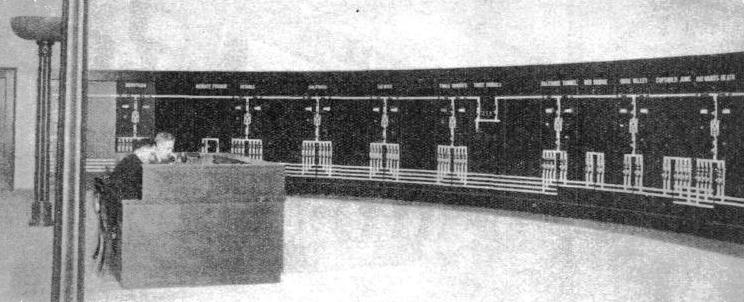
CENTRALIZED CONTROL. The interior of the great semi-circular hall at Three Bridges, from which is controlled the distribution of electric current from the main power stations to the sub-stations on the main Brighton line. The sub-stations supply current to the third rail of the track. Should a breakdown occur at any part of the system, an indication is given to the engineers at the central desk by the illuminated diagram on the wall in front of them.
On the other hand, the frequency of the trains may be limited by other factors. Of these, the principal are the ways in which the tracks themselves are arranged, especially at junctions, and the type of signalling in use. Where junctions of double lines are arranged on the flat, it means inevitably that at least two of the tracks have to cross one another on the level, and that wider intervals between the trains passing through the junction are required in order to allow time for the switch and signal movements necessary to prevent collisions. If ordinary “manual” signalling is used, the space between trains is limited by the speed at which the signalmen in the boxes can carry out the necessary bell-signalling from box to box and the lever movements.
Added to the cost of electrification is the expenditure on all kinds of track alterations, and on the installation of electric signalling, both of which are essential if the maximum possible value is to be derived from the electrification itself. In this connexion the Southern Railway has decided to spend £500,000 in improving the approaches to Waterloo terminus. Out of Waterloo, which handles 1,550 train movements daily, there are eight running lines. The north side of the station accommodates the trains for the Putney, Reading and Windsor lines; in the centre the main line trains arrive and depart; and on the south side are the platforms for the suburban trains, which follow the main line to Wimbledon and beyond.
The Reading and Windsor trains keep to their separate tracks as far as Clapham Junction, where they diverge from the main lines, and so give no trouble. But the main lines have their two fast tracks in the centre, with the up and down suburban tracks on the outside; this facilitates the divergence of the various suburban trains to their branches at Raynes Park, Malden, Surbiton, and elsewhere, as these branches are led off by means of tunnels or overbridges - “burrowing” or “flying” junctions, as they are called - and the branching suburban trains do not therefore have to cross any other tracks on the level.
The Problem of Waterloo
But what is of such value at the suburban stations is all wrong at Waterloo; for as all the up suburban electrics from the main line direction approach Waterloo they have to be switched on the flat right across the up and down fast tracks, in order to reach their own platforms on the south side of the station, in readiness for departure on the down suburban line. This means many complicated signal and switch movements, as well as considerable delay to trains at busy hours.
To construct a “fly-over” to carry the up suburban across the up and down fast lines in the immediate vicinity of Waterloo would be a costly business, and the necessary “fly-over” has been designed for Durnsford Road, east of Wimbledon, and from there to Waterloo all the tracks had to be planned for rearrangement so that the up suburban could become the up fast line; the up fast line which, throughout the history of this route has carried expresses at high speed towards London, has been designed to carry them in the opposite direction; the down fast line becoming the up slow line.
Electric signalling, it was decided, should ultimately be installed all the way from Waterloo to Hampton Court Junction, beyond Surbiton, a distance of 13½ miles. Between the various junctions this signalling, as on other electrified sections of the Southern Railway, can only be automatic; at the junction points many of the ordinary signal cabins would not be suitable. The working must be concentrated in large cabins containing complex electrically-worked signal-frames. One advantage of electrical signal-working is its simplicity. In a manually-worked signal-frame every movement of a signal, a switch, or a locking-bar involves a separate movement of a lever; but in an electric signal-frame, by suitable connexions and relays, one single flick of a miniature lever can be made to perform a whole series of switch and signal movements. And, of course, it requires no physical exertion on the part of the signalman. The great bridge of signals outside Waterloo Station, with “A” signal-box in the centre, which has been so familiar a feature of the view, must inevitably be superseded.
Here, then, is an instance in which electric operation of trains has been proceeding for nearly twenty years. It is continually being speeded up, not always by means of new electrical rolling-stock, but more frequently by modernization of signalling and track. In this way there is a constant reduction in the headway between the suburban electrics into and out of the south side of Waterloo varying at present from 4 min to between 2½ and 2 min, and a tendency to eliminate all the delays.
The installation of electric signalling has also considerable economic advantages in enabling signal-boxes and signalmen to be dispensed with. At London Bridge - which handles no fewer than 2,400 trains daily - when electrification was brought into use, the four cabins previously in use were replaced by one large new signal-box. This had a signal-frame of 311 levers - the largest electric signal-frame in the world - controlling the whole of the train movements through the High Level Station, and also into and out of the Low Level terminus. Where fifty men and twelve boys were needed daily, in three shifts, to work the previous four signal-boxes, the present box is worked by sixteen men and eight boys. At the busiest times of the day six men are needed to work the frame -each having his own section of the frame to look after-and four boys to record the movements of the trains in the signal-box books.
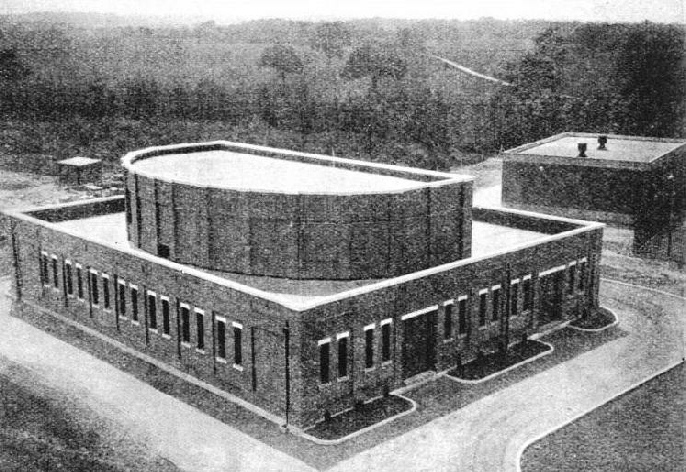
THREE BRIDGES CONTROL STATION has on the roof a semi-circular hall, the interior of which is illustrated above. The lower part of the station houses the transformers which supply electric power at the required voltage to the conductor rails of the track.
At Brighton another new electric signal-box with 225 power-operated levers has replaced six mechanically-operated cabins, which had 582 levers between them. Between Coulsdon and Brighton alone fifteen signal-boxes were closed entirely, and were replaced by automatic signalling. Certain others, such as the boxes at Balcombe, Burgess Hill, and Hassocks are “switched in” only when shunting requires to be performed at these stations; at other times trains are signalled past them automatically.
Novel systems in this connexion include the electrical working of the junctions at Copyhold from Haywards Heath signal-box, 2,100 yards away.
In the London suburban area the electric signalling is partly “three-aspect” and partly “four-aspect”. Three-aspect light signals show red for “stop”, yellow for “one section ahead clear”, and green for “two sections or more ahead clear”. These correspond to a signal-post with “home” and “distant” signal-arms carried on it, showing respectively both arms at danger; the home signal “off” and the distant signal “on”; and both home and distant signals “off”. But the four-aspect signal has two yellow lamps, and so can show double yellow for “one section ahead clear”; single yellow for “two sections ahead clear”; and green for “three or more sections ahead clear”. In the latter instance the sections are usually somewhat shorter, and the doubling of the yellow indication helps to keep traffic moving at its maximum density on lines that carry an exceptionally frequent service of trains.
Remarkable Suburban Stations
So far as track arrangements are concerned most of the junctions in the London suburban area of the late South-Eastern and Chatham, London, Brighton and South Coast, and London and South Western Railways were admirably laid out to permit of the maximum possible number of trains being run over them.
Probably the most remarkable system of junctions in the country is that north of Croydon. Here the main line from Victoria meets that from London Bridge; both are four-tracked, the former having its fast lines on the west side and slow lines on the east side, and the latter with its fast lines in the centre, and the up and down slow lines outside. The slow lines from Victoria have to be brought across to the opposite, or east, side of the fast lines before reaching East Croydon; the down slow line from London Bridge has to be carried across the fast lines to their west side, in order to join the up slow line; and, in addition, both London Bridge and. Victoria lines have to throw off a branch to West Croydon. All this is done by a series of flying and burrowing junctions, with the help of which conflicting train movements are practically eliminated.
Another complicated junction system occurs where the old South-Eastern main line crosses the old Chatham main line near Chislehurst. Apart, therefore, from the Wimbledon and Waterloo track re-arrangement which it is proposed to undertake, the Southern Railway management, in setting about its gigantic task of suburban electrification, has found its ramified suburban junctions arranged for steam trains in such a way as to facilitate electric operation to the utmost.
The current for the long-distance electrification, from Purley on to Brighton and Worthing, is taken from the grid of the Central Electricity Board From three of its sub-stations at Croydon, Three Bridges, and Southwick, the main 132,000-volt system feeds transformers giving supplies to the railway high-tension system, at 33,000 volts, 50 cycles.
But the main feature of interest in this installation is the way in which all the eighteen railway sub-stations, transforming the current from 33,000 volts to the line voltage of 650 DC, with which the conductor rails are charged, are distantly controlled from one central control room at Three Bridges.
The two controllers at Three Bridges sit at a desk in the middle of the large D-shaped room, which forms the upper storey of the control building at Three Bridges. Round the semi-circular side of the D, in their full view as they sit, is a diagrammatic representation of the entire area under their control. Each sub-station is shown on this long panel, and by means of light indications the controllers are kept continuously aware of what is going on at each sub-station.
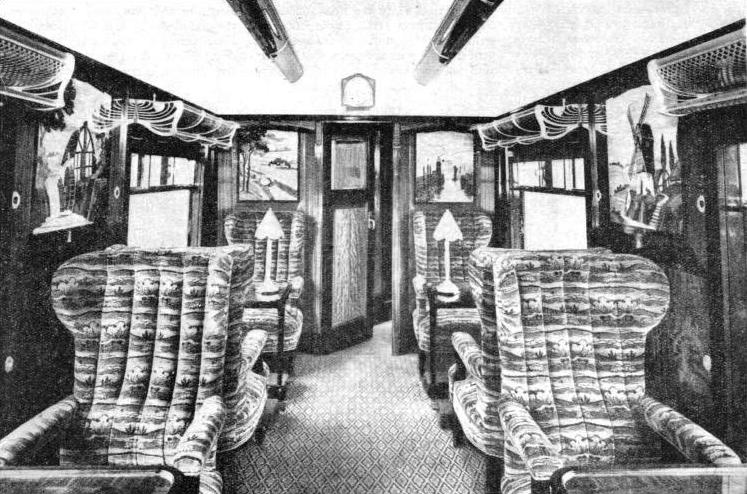
SPEED AND COMFORT are combined on the Southern Railway’s electric services. This interior view gives an impression of the luxurious appointments of a modern railway carriage.
The development of a fault at any one of the sub-stations immediately becomes apparent, both visually and audibly, on the main control panel. Temporarily that defective sub-station can he cut out directly from the control room, and current fed to the affected section from another source until men, dispatched at once to rectify the trouble, have done their work.
Telephonic communication is provided between the control office and each sub-station. The fact that all these sub-stations are normally unattended makes, of course, for considerable economy; it is the most extensive system of remote control in existence, and functions perfectly.
“Rush Hour” Traffic
Another novelty at these sub-stations is that, instead of the rotary converters hitherto almost universally employed to make the change from alternating to direct current, each station contains a single 2,500-kilowatt rectifier, fed with current by an outside transformer.
Now the trains themselves require description. Throughout the Southern electrification area “multiple-unit” electric trains are in use. The two methods of working electric services are, first, to use independent electric locomotives, and second, to equip each “unit” of rolling stock in such a way that it can propel itself. The former has the advantage that trains made up of ordinary passenger stock, and also freight trains, can be worked over electrified lines. In the latter type each train is a self-contained unit, requiring the attachment of no locomotive, nor the running of the locomotive round at the terminus before returning.
For suburban service, multiple-unit trains are in almost universal use; the Southern units are of three cars, a third-class motor and brake-coach at each end, and a composite first and third-class coach in the centre. Each motor-coach is provided with motor-driving equipment and brushes for picking up the current from the live rail; it also has driving compartments at each end, but at whichever end the driver may be working, he controls the working of both motors. At “rush hours” two units are coupled together, making six cars, driven by motors at four different points along the length of the train; but all the motors are still under the control of the one driver; hence the name “multiple unit”. At the busiest times, two third-class “trailer” coaches are attached, between the two motor-driven units, to provide additional accommodation, making eight cars in all.
But the use of multiple-unit trains for long-distance work is more unusual. For various reasons, however, the Southern directors decided to extend multiple-unit working to the coast. One reason was that the traffic, with its “rush hours” to London in the mornings, and from London in the evenings, is not very dissimilar from that in the suburban area. Another reason was the frequency of junctions along the route, with the accompanying difficulty of wide gaps in the conductor rails through the switch and crossing work. These gaps are of no consequence in multiple-unit working, as current is being picked up at various points along the train; but with independent electric locomotives it would have been necessary, either to attempt to close these gaps in some way-which would have been difficult-or to provide the junction sections of the line with overhead as well as third-rail conductors, and to equip the locomotives for both overhead and third-rail working. Otherwise an electric locomotive might stop on one of the gaps and be unable to re-start. The result of the decision in favour of multiple-unit trains is that all goods traffic has to be worked by steam locomotives, for the most part during the period late at night when the electric service is suspended.
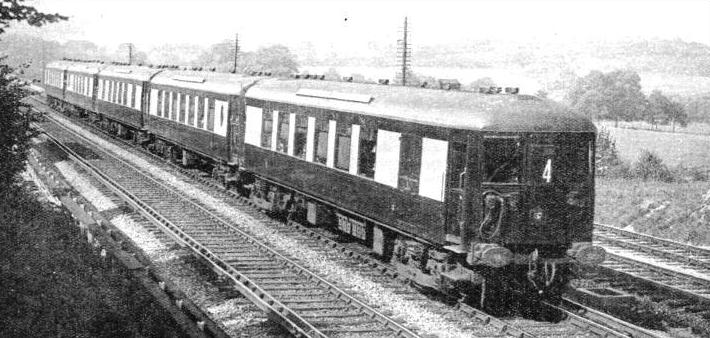
"BRIGHTON BELLE," crack electric express of the Southern Railway. The train runs thrice daily between Victoria Station, London, and the terminus at Brighton, covering the fifty-one miles in sixty minutes. The "Brighton Belle" replaced the steam-hauled "Southern Belle", the first all-Pullman express in Britain, which during a quarter of a century carried over four and three-quarter million passengers.
Although much of the stock used in the suburban electric services (trailer cars in particular) was adapted from the coaches in use in steam days, all the rolling-stock on the long-distance services has been specially built for the electrification. For the extension to Brighton and Worthing alone 285 new cars were built, including 38 Pullman cars. The most remarkable units, of course, are those used in the all-Pullman “Brighton Belle”.
Never previously in railway history have “motor Pullmans” been constructed. Three units have been built for this service, each comprising five cars measuring 68 ft 9 in over the buffers, and all equipped in the most up-to-date Pullman fashion. The motor Pullmans arc the heaviest vehicles yet put on British metals, for they weigh 62 tons apiece.
Biggest in the World
A complete unit consists of third-class motor Pullman brakes at each end, furnished with driving compartments, a third-class Pullman, and two first-class Pullmans with kitchens, together weighing 249 tons, and accommodating 152 third-class and 40 first-class passengers. At busy times two units are run in conjunction, making 10 cars and weighing 498 tons, and the third unit is kept in reserve.
Then there are the corridor units for the ordinary express trains, each made up of six coaches (one of which is a Pullman car), seating 236 third-class and 72 first-class passengers, and weighing 266 tons. At “rush hours” these units are run in pairs, and with their twelve coaches, weighing 532 tons, they are the biggest multiple-unit trains in the world.
Seating accommodation is provided for over 600 passengers per train, and refreshments are served to passengers in their compartments by the attendants from the Pullman cars. Thirty-three four-coach non-corridor units, weighing 139 tons each, have also been provided for the slow and the semi-fast services.
There are some interesting features about these Pullman cars, which are of all-steel construction. The abundant supply of electricity is used for a variety of purposes. There is, first of all, cooking, all of which is electric, together with the boiling of water for making tea. Electricity is used for heating the air in the air-conditioning plant, which supplies warm or cool air to the cars according to the season, and for heating the water in the toilet compartments. Electric light-signals above the seats show the attendants in the cars exactly where a passenger's bell has been rung.
Another feature of the cars is the readiness with which all the furniture can be moved, so opening up the whole of the interiors for cleaning.
In the Southern Railway’s own stock that has been built for these services many novelties have been introduced, such as arm-rests in the third-class compartments, comfortable cushioning, and ultra-modern decorations.
The train services are some of the most lavish in the world over so great a distance. At every hour from 9 in the morning to 12 midnight a 60-minute, non-stop express leaves London for Brighton, with three additional 60-minute workings, and correspondingly in the opposite direction. Midway between these are expresses for Hove and Worthing, calling intermediately at East Croydon and Haywards Heath only.
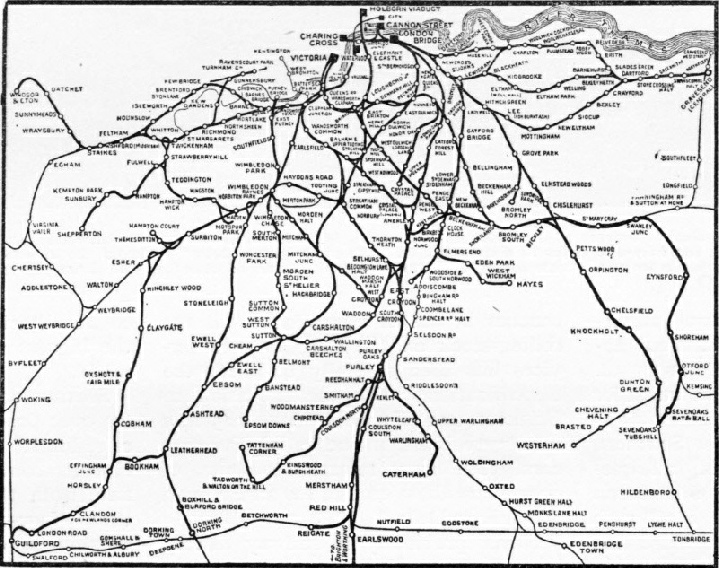
THE GREAT NETWORK in the Southern Railway’s suburban area. Thick lines denote electrified track, the thin lines show routes served by steam trains.
Then there are semi-fast services, with limited stops, from both London Bridge and Victoria to Brighton, taking only 74 minutes on the journey: and finally there are the stopping trains, also hourly from both terminals, which together make six trains hourly in each direction along the main line between Coulsdon and Preston Park, with steam trains sandwiched in to and from the Portsmouth line via Three Bridges. and to and from the Eastbourne and Hastings line via Keymer Junction. In time, the Keymer Junction route will be worked electrically and no steam trains will be seen between Three Bridges and Brighton, except for the freight trains at night.
It is no secret that times far quicker than 60 minutes from London to Brighton were achieved by electric trains when preliminary experiments were being made. The quickest time on record for the 51 miles from Victoria to Brighton was 46 minutes 43 seconds from start-to-stop, including the cautious running necessary until the limits of the London suburban area had been cleared; after that speeds in excess of 80 miles an hour were reached.
But it was rightly considered that punctuality would be one of the most important assets of the now electrified service, and that strict punctuality would be possible if the electric trains had plenty of power in reserve. And so, when the express trains are running to time, the drivers are instructed, as soon as they have reached the summits of certain specified long gradients, to shut off the current, and to run their trains by gravity alone; and special display boards are erected at the line-side to remind them to do so. Thus it frequently happens that a Brighton 60-minute train runs faster uphill than downhill.
But if trains have been delayed by signal or permanent way checks, then the driver has the capacity for fast downhill running, and speeds of 75 miles an hour and more will be attained in order to recoup the lost time and to arrive punctually. So it is clear that no stone has been left unturned by the Southern Railway management to ensure success in the working of this vast electrical enterprise.
As a conclusion to this article, it is fitting that we should make a journey by one of the “Brighton Electrics”, and the most attractive train to choose for the purpose is, of course, the “Brighton Belle”.
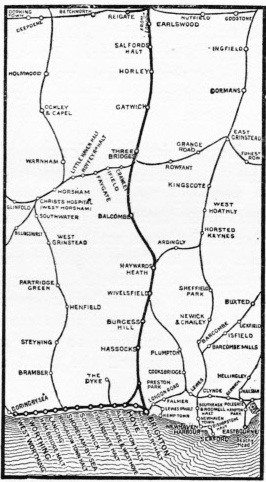 For many years after its first introduction, during the days when, it was hauled by steam locomotives, this train was known as the “Southern Belle”, and was content to make one double journey a day; now the “Brighton Belle” runs from Victoria to Brighton and back three times every day, making a total mileage of about 306 a day, and 2,142 a week. In the whole year more than two thousand journeys - 2,190 to be exact - are made by the “Belle”, covering approximately 111,690 miles, which is equivalent to more than four times round the world.
For many years after its first introduction, during the days when, it was hauled by steam locomotives, this train was known as the “Southern Belle”, and was content to make one double journey a day; now the “Brighton Belle” runs from Victoria to Brighton and back three times every day, making a total mileage of about 306 a day, and 2,142 a week. In the whole year more than two thousand journeys - 2,190 to be exact - are made by the “Belle”, covering approximately 111,690 miles, which is equivalent to more than four times round the world.
THE LINE TO THE COAST, from the North Downs to the English Channel.
The three departures from London are at 11 o’clock in the morning, three in the afternoon, and seven in the evening, returning from Brighton to Victoria at 1.25, 5.25, and 9.25 pm. If we catch the 11 am down, we shall start neck-and-neck out of Victoria with another Pullman express - the “Golden Arrow” -on its way out of the Eastern side of the station to Dover, with passengers for the Continent. But although the “Golden Arrow” is hauled by a powerful 4-cylinder 4-6-0 locomotive of the “Lord Nelson” type, and has another locomotive banking in the rear until the climb on to the Grosvenor Road Bridge over the Thames has been surmounted, the “Brighton Belle” is certain to pass the steam-hauled train. For electricity makes light of the 1 in 64 climb on to the bridge, and soon we have surmounted the gradient, and are swinging across the many tracks of the Western Division main line down to Clapham Junction.
The short distance between Pouparts Junction signal-box and Clapham Junction Station, where the old London, Brighton & South Coast and London & South Western tracks ran alongside each other, is the widest stretch of running lines anywhere in the country; and its nearest rival is the group of lines running eastwards from London Bridge Station. Both now belong in their entirety to the Southern Railway and in both instances the lines are all electrically equipped and, in consequence, busier than ever. More trains pass through Clapham Junction in a day than through any other station in Great Britain.
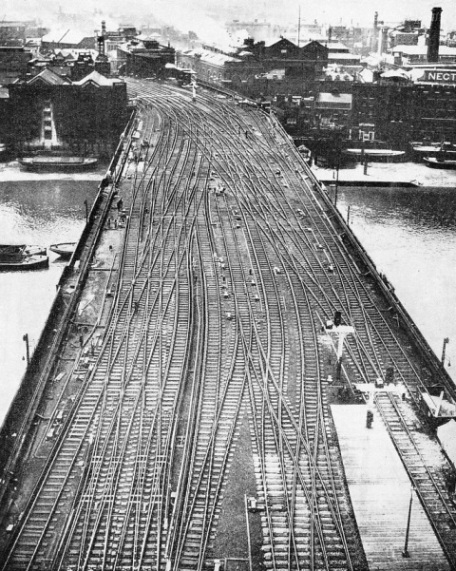 From here onwards the main line to Brighton is on rising gradients for 16 miles. It has three well-defined “peaks”, each of which is crowned with a tunnel. First comes Quarry summit, beyond Coulsdon; then Balcombe summit, beyond Three Bridges; and lastly Clayton summit, about 5 miles outside Brighton. At the bottom of the switchbacks, between the summits, lie Horley, between Quarry and Balcombe, and Haywards Heath, between Balcombe and Clayton.
From here onwards the main line to Brighton is on rising gradients for 16 miles. It has three well-defined “peaks”, each of which is crowned with a tunnel. First comes Quarry summit, beyond Coulsdon; then Balcombe summit, beyond Three Bridges; and lastly Clayton summit, about 5 miles outside Brighton. At the bottom of the switchbacks, between the summits, lie Horley, between Quarry and Balcombe, and Haywards Heath, between Balcombe and Clayton.
LABYRINTH OF LINES running southward over the Thames just outside Cannon Street Station. This London terminus handles an enormous volume of suburban traffic, and all the points and signals are operated by electricity.
A little less than ten miles out of Victoria comes the complex system of junctions north of Croydon. First, the slow lines dive down under the track on which we are running. Then at Windmill Bridge Junction we join the lines from London Bridge, and immediately afterwards clear East Croydon Station, where speed may be increased to Coulsdon North. Mounting through a deep chalk cutting, in the middle of which the original route is crossed, we pass through Quarry Tunnel, and then drop down, first along a high embankment, and then through a short tunnel “by-passing” Redhill Junction, to rejoin the old route at Earlswood, whence there are four tracks once again. Continuing downward, we reach the bottom of the dip at Horley, and then once again begin to climb. In the middle of this ascent comes Three Bridges Junction. Then, at Balcombe Tunnel signal-box the four tracks converge to two, the second summit is reached, and we pass through Lacombe Tunnel itself.
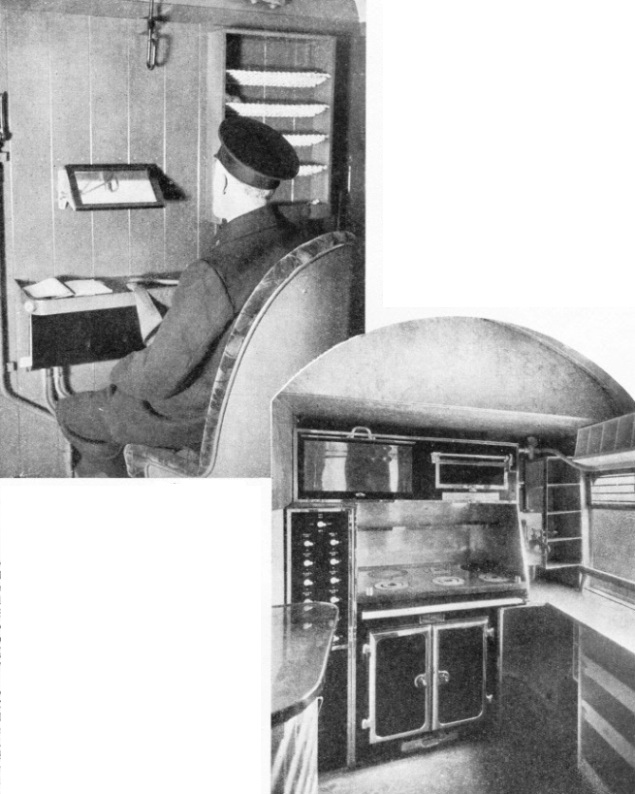
THE GUARD of an electric train is provided with a periscope giving a clear view of the track ahead. The periscope comprises a pair of inclined mirrors, one placed in a housing in the roof, the other on the wall of the guard’s compartment.
ALL-ELECTRIC KITCHENS form an essential part of the Pullman equipment on the Southern Railway's main line service to Brighton and adjacent towns. The most up-to-date appliances facilitate the work of the chef preparing meals when travelling at sixty miles an hour.
This stretch of track is one of the busiest sections of the route, as only two tracks have now to carry all the trains. But it would be costly to widen, as in addition to Balcombe Tunnel there is the great stone viaduct, near Balcombe, over the Ouse Valley. Travelling at high speed through Haywards Heath we pass Wivelsfield, and, beyond, Keymer Junction.
Clayton Tunnel, over a mile in length, carries the train up to the last of the three summits, at its southern portal. Another deep chalk cutting, and the “Brighton Belle” dashes down the final 1 in 264 to Preston Park, where the Hove and Worthing line branches to the west. And finally we travel smoothly into Brighton Central Station, exactly one hour after leaving Victoria.
You can read more on “Electric Railways”, “The Southern Belle” and “The Story of the Southern” on this website.











 For many years after its first introduction, during the days when, it was hauled by steam locomotives, this train was known as the “Southern Belle”, and was content to make one double journey a day; now the “Brighton Belle” runs from Victoria to Brighton and back three times every day, making a total mileage of about 306 a day, and 2,142 a week. In the whole year more than two thousand journeys -
For many years after its first introduction, during the days when, it was hauled by steam locomotives, this train was known as the “Southern Belle”, and was content to make one double journey a day; now the “Brighton Belle” runs from Victoria to Brighton and back three times every day, making a total mileage of about 306 a day, and 2,142 a week. In the whole year more than two thousand journeys - From here onwards the main line to Brighton is on rising gradients for 16 miles. It has three well-
From here onwards the main line to Brighton is on rising gradients for 16 miles. It has three well-